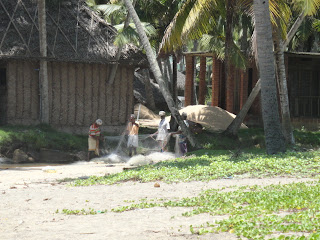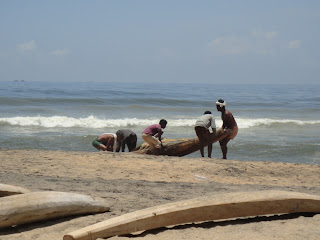When I arrive from Alleppey I don’t feel well and sleep for much of the first day. I emerge in the afternoon to discover where I am and go in search of a cup of tea and something bland to eat – a piece of toast would be just right.
Varkalla beach is a touristy seaside place and the noise of the Arabian sea is always there in the background as it crashes constantly against the cliffs. My accommodation is in a block of 8 rooms, just set back from the cliff and about 1km from the main beach and at the far end of the touristiness. The room is rather dingy, but it has a nice shady area for sitting out and a view through the palm trees to the sea.
Sunset from my room
I wander out to the cliff, past 3-4 bamboo shops with the shopkeepers outside – ‘Look in my shop, I have nice things’- and a blind beggar and find a restaurant within 100m. It is run by some quiet Nepalese men and comes with free wi-fi and tea and toast with honey. We talk about the earthquake that has just happened in Northern India and Nepal. We take a look at the internet on my laptop, but there is very little news yet and they are scared and worried for their families. Selfishly I can’t help wondering if this will affect the next part of my trip. I am due to fly to Kathmandu in a week.
There are very few tourists round, being before the main season, which starts in Oct/Nov. Germans seem to make up the largest group of westerners. I don’t have a highly efficient gay-dar, but am aware that there seem to be several pairs of male friends around. Two very thin men sit together at the front of the café and then get up to compare the flexibility of their shoulders. They talk about their fitness regimes in accented English. The Nepalese waiters smile and look confused.
The second day I am feeling better again and walk along the cliff in both directions to get a better feel for the place. First of all I follow a brick-built walkway north, away from the tourist area. The cliffs are lower here and a rip-rap of boulders protects the shore, but makes it impossible to get to the water until the next little sandy beach, called Odayam.
Coast north of Varkalla
I find a little shade at the back of the beach and sit on a log under some palm trees. It is very quiet on the beach. In some shade at the back some men are sorting out fishing nets. Lying on the beach are lengths of cut and shaped trunks of palm trees arranged in groups of 3.
Sorting out fishing nets
The waves look ferocious and there are no lifeguards here. One of the thin men from yesterday is in the sea and jumping in and through the waves vigorously. I worry for his safety. I watch an Indian man walk to the edge of the sea, he stands in the shallows and waves a cloth above his head and shouts. I think he is waving to the thin man, but then realise there is a tiny boat just beyond the surf and he is waving to it to come in. Two men turn the boat and paddle it through the surf to the shore.
Fisherman calls in the boat
The three of them drag it beyond the waves and then undo chords attached at each end and the boat comes apart into three pieces – like those lying on the beach. Two of them lift the pieces one at a time onto their shoulders and lay them in a group at the back of the beach. The 3rd man picks up a bundle of netting that was on the boat and takes it to a hut at the back of the beach.
Pulling in the boat
Two male tourists walk along the beach and join me on my log. They are German and we chat a little. One of them is funny and jokes about fish and chips and India belonging to the British. When they get up to leave he says, ‘God save the Queen’. I wonder if he is referring to Elizabeth or maybe himself?’ Long live Angela Merkel’ I respond, demonstrating an unusual general knowledge for me!
Further north I pass a colourful mosque and few closed-up tourist bungalows, but other than that there doesn’t seem to be much else and it’s too hot to walk far.
Mosque
Later in the day I walk in the other direction. The main tourist area is a collection of restaurants, shops and accommodation that stretch for about 1km along the higher North Cliff, before dropping down to Varkalla beach. Some places have not yet opened for the season and others are undergoing building and renovation.
Pre-season renovation
When I arrive at the beach itself in the late afternoon there are very few people there. A red flag is flying. The tide does not seem to move very far and there isn’t a large amount of beach.
Varkalla beach
In the early evening when it is cooler there is more going on. The Indians come out and stand on the beach. 2 lifeguards watch to make sure no-on goes in the water.
Early evening on the beach
Later a rickshaw driver tells me that in the main season the beach is very large and many tourists come and sleep there. Can it really be that the high tide line is so very different at different seasons? I must ask Andrew, he’ll be sure to know; or if not he’ll make up something that sounds plausible.
Some men are selling fish off a tarpaulin spread on the sand.
Selling fish off the beach
The next day I wake early and before it gets too hot I walk again to Odayam beach. This time the beach is a hive of local male fishing-related activity. Two men sit together at one side and mend a net in silence. At the back of the beach a group of men use wooden poles to lever a big boat onto its side. They then set about banging its bottom with mallets. On the main part of the beach a large group of men are untangling some nets. From time to time a man wades into the sea, loosens his dhoti and washes his nether regions. The whole scene feels too private and too masculine for me to intrude, so I sit for a while behind a hut on the nearside of the beach and watch some crabs scuttling around in a rock pool.
Morning beach activity
It struck me that both beaches felt very different at different times of the day.
I take trip to Varkalla town which is about 4km away to do some shopping. On the way I pass this large man-made pool, which belongs to the nearby Hindu temple. Can see it being used for washing – bodies and clothes – and one man is swimming a gentle backstroke across the middle. I don’t know if it has any religious significance or whether it is just a community facility.
Temple pool
I would like to buy a Keralan sari as a souvenir of my time here and some things for the grandchildren. I find a large shop with models outside wearing saris and girls and boys clothes. It is a proper walk-in shop, with shoes left at the door. It is a little intimidating, as there is nothing on display to choose from, everything is neatly wrapped in cellophane and stacked behind long counters with plenty of staff to serve. I point to some material of plain undyed cotton with a gold boarder that looks about right. Very soon packets are opened and metres of material are shown to me. I begin to understand that the price is affected by the quality of the cotton and the intricacy of the work. A simple one with a gold border is about 400ruppees (about £5) and the most intricate one with peacocks and elephants embroidered on is about 4000 ruppees (about £50). I go or a simple design, as this is what I have seen being worn. Next I tackle the purchase of a dress for Megan. Girls clothes are on the floor above. Again everything is packed away on shelves behind the counter. 4 young girls help me, while giggling to each other. I indicate the approximate height of Megan and her age and point to the packets of pink clothes – Megan is a very pink girl! Eventually I choose a two piece confection with silver beads from the heap of possibilities on the counter. The boys and men’s clothes are up one floor again and the 4 girls take me up there. There is far less choice for boys in that they wear shirts and jeans – but I have never seen so many shirts in one room. I explain that I liked a little checked shirt on one of the dummies outside the shop. One of the girls goes down the two floors and comes back with him. There is much laughter as the dummies arms fall off as they all try to undress him.
The girls carry my 3 choices downstairs. The process of packing and paying is equally labour-intensive. The girls pass the items to a man behind a counter who puts them into paper bags. He tells another man the prices. He prints out the receipts, which are passed to a girl at the cash desk who takes my money. Mission accomplished!
Clothes shop – ground floor
Back on North Cliff I have seen a shop advertising a seemingly strange combination of services – dress making and parcel packing. I go to talk to them about how to send my items back home. The parcel is weighed and there and then they make a cover from the parcel by stitching it up in material using a treadle sewing machine– ingenious! Having paid for the postage and the packing service I leave the parcel with them together with Kate’s address written on a slip of paper. Let me know if it arrives safely in a couple of weeks, Kate.
Re the earthquake – I checked the news each day with the Nepalese waiters. By day four the death toll is up to 78, but all their families are safe. The main damage seems to have been in Sikkim. I contact my travel agent who looks into it and they get back to me to say that the local tour operator has an office in Kathmandu and for now it is quite safe for the tour to go ahead as planned. They will let me know if anything changes.















2 comments:
What a wonderful shopping trip you experienced - sounds great for creating lots of jobs! It would reduce our unemployment at a stroke! Wendy x x
hi helen
Good to read about all your adventures, and the photos really bring it to life for us back home in (rather dull compared!) Devon.
I am a little disappointed to see a typo in your text - clearly the standards are slipping, or is it that jen and I are not there to keep you in check! ha ha... anyway, keep up the blog, as it is really good to hear about your travels.
travel safely
Love Nick + Gill xx
Post a Comment